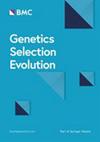对肌肉脂肪含量不同选择的家兔进行双变量GWAS,揭示了与肉和胴体品质性状相关的多效基因组区域和基因
IF 3.1
1区 农林科学
Q1 AGRICULTURE, DAIRY & ANIMAL SCIENCE
引用次数: 0
摘要
肉类质量在肉类工业和牲畜育种计划中起着重要的经济作用。肌内脂肪含量(IMF)是肉质的主要参数之一,其遗传改良促使育种家研究其基因组结构及其与其他相关性状的相关性。与这些性状的因果变异相关的遗传标记可以通过双变量分析来确定。在这项研究中,我们使用两个分散选择的兔系进行双变量GWAS,目的是检测IMF与几个体重、脂肪和肉品质性状之间的多效性基因组区域。此外,来自这些品系的全基因组测序数据用于鉴定与遗传标记相关的潜在因果变异。主要的多效区位于Oryctolagus cuniculus染色体(OCC) 1上,位于35.4 Mb ~ 38.2 Mb之间,解释了IMF遗传变异的2.66%,并与除肌肉轻度外的所有性状相关。在该地区,发现的潜在因果变异指向PLIN2、SH3GL2、CNTLN和BNC2是影响不同体重、脂肪库和肉质性状的主要候选基因。在OCC3 (148.94 ~ 150.89 Mb)和OCC7 (27.07 ~ 28.44 Mb)上发现了其他相关的多效区。前者与所有脂肪储备性状相关,解释了最高百分比的遗传变异,高达10.90%的肩胛骨脂肪。在该区域发现了几个等位基因变异,均位于新基因ENSOCUG00000000157(与其他物种的ST3GAL1同源)上,参与脂质代谢,表明它是影响脂肪沉积的主要候选基因。OCC7上的这个区域与大部分肉质性状相关,解释了8.48%的ph遗传变异,在这个区域内没有发现等位基因变异在品系间分离差异;然而,它仍然是未来功能研究的一个有前景的领域。我们的研究结果表明,假设多效性效应的双变量模型是识别与IMF和一些体重、脂肪和肉质性状同时相关的基因组区域的有价值的工具。总的来说,我们的研究结果在基因组水平上对性状之间的相关性和关系以及潜在的功能突变提供了相关的见解,这将与兔和其他牲畜育种计划的探索相关。本文章由计算机程序翻译,如有差异,请以英文原文为准。
Bivariate GWAS performed on rabbits divergently selected for intramuscular fat content reveals pleiotropic genomic regions and genes related to meat and carcass quality traits
Meat quality plays an important economic role in the meat industry and livestock breeding programmes. Intramuscular fat content (IMF) is one of the main meat quality parameters and its genetic improvement has led breeders to investigate its genomic architecture and correlation with other relevant traits. Genetic markers associated with causal variants for these traits can be identified by bivariate analyses. In this study, we used two rabbit lines divergently selected for IMF to perform bivariate GWAS with the aim of detecting pleiotropic genomic regions between IMF and several weight, fat, and meat quality traits. Additionally, whole-genome sequencing data from these lines were used to identify potential causal variants associated with the genetic markers. The main pleiotropic region was found on Oryctolagus cuniculus chromosome (OCC) 1 between 35.4 Mb and 38.2 Mb, explaining up to 2.66% of the IMF genetic variance and being associated with all traits analysed, except muscle lightness. In this region, the potentially causal variants found pointed to PLIN2, SH3GL2, CNTLN, and BNC2 as the main candidate genes affecting the different weight, fat depots and meat quality traits. Other relevant pleiotropic regions found were those on OCC3 (148.94–150.89 Mb) and on OCC7 (27.07–28.44 Mb). The first was associated with all fat depot traits and explained the highest percentage of genetic variance, up to 10.90% for scapular fat. Several allelic variants were found in this region, all located in the novel gene ENSOCUG00000000157 (orthologous to ST3GAL1 in other species), involved in lipid metabolism, suggesting it as the main candidate affecting fat deposition. The region on OCC7 was associated with most meat quality traits and explained 8.48% of the genetic variance for pH. No allele variants were found to segregate differently between the lines in this region; however, it remains a promising region for future functional studies. Our results showed that bivariate models assuming pleiotropic effects are valuable tools to identify genomic regions simultaneously associated with IMF and several weight, fat and meat quality traits. Overall, our results provided relevant insights into the correlations and relationships between traits at the genomic level, together with potential functional mutations, which would be relevant for exploration in rabbit and other livestock breeding programmes.
求助全文
通过发布文献求助,成功后即可免费获取论文全文。
去求助
来源期刊

Genetics Selection Evolution
生物-奶制品与动物科学
CiteScore
6.50
自引率
9.80%
发文量
74
审稿时长
1 months
期刊介绍:
Genetics Selection Evolution invites basic, applied and methodological content that will aid the current understanding and the utilization of genetic variability in domestic animal species. Although the focus is on domestic animal species, research on other species is invited if it contributes to the understanding of the use of genetic variability in domestic animals. Genetics Selection Evolution publishes results from all levels of study, from the gene to the quantitative trait, from the individual to the population, the breed or the species. Contributions concerning both the biological approach, from molecular genetics to quantitative genetics, as well as the mathematical approach, from population genetics to statistics, are welcome. Specific areas of interest include but are not limited to: gene and QTL identification, mapping and characterization, analysis of new phenotypes, high-throughput SNP data analysis, functional genomics, cytogenetics, genetic diversity of populations and breeds, genetic evaluation, applied and experimental selection, genomic selection, selection efficiency, and statistical methodology for the genetic analysis of phenotypes with quantitative and mixed inheritance.
 求助内容:
求助内容: 应助结果提醒方式:
应助结果提醒方式:


